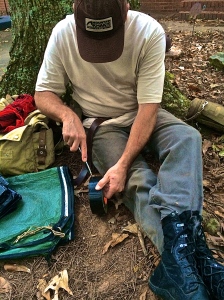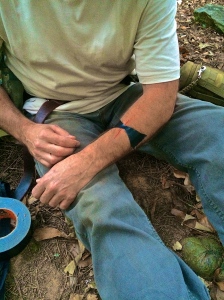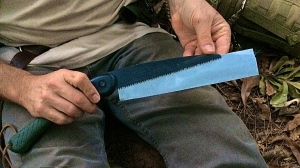by Todd Walker
Fall is a season where many of us head out to enjoy the outdoors. Crisp air, colorful leaves, deer in rut, and clear mountain streams lure us to nature. Unfortunately, there are times when things go sideways on day hikes and canoe trips. When they do, you’ll need knowledge, skills, and resources to get home safely.
The goal of wilderness survival is simple… to effect self-rescue or be found alive. Even “minor” injures in a 72 hour scenario can decrease your chances of meeting that goal.
Self-aid should become a top priority on your skills list. Why?
You’re likely to come in contact with sharp stuff, hot stuff, slippery stuff, and/or stinging stuff on outings. I rarely leave the woods without one of these most common wilderness injuries:
- Cuts/Abrasions
- Burns
- Breaks/Strains/Sprains
- Bites/Stings
- Blisters
You may choose to carry a first-aid kit to treat these injuries. That is a smart option. Let me state upfront, if you require daily medication for health issues, by all means, be sure to pack enough of your meds.
Can your 10 piece kit double as a self-aid/first-aid kit? Indeed it can!
First, here are the 10 essential items that should go with you on every trip to the woods…
The 10 C’s of Survivability (10 Piece Kit)
- Cutting tool
- Combustion device
- Container
- Cover
- Cordage
- Cotton bandana
- Cargo tape
- Cloth sail needle
- Candling device
- Compass
Look beyond the obvious uses for these 10 items – shelter, fire, navigation, water, etc., etc. With a little creativity, your 10 C’s can effectively treat each of the most common injuries in a 72 hour wilderness survival scenario.
Here’s how…
(Adapted from Brian Manning’s hand-out and Jason Hunt’s class on wilderness self-aid at The Pathfinder School)
Cuts and Abrasions
- Cutting tool – use knife to remove debris from wounds
- Combustion device – sterilize tools
- Container – irrigate and wash wound with water
- Cover – (drum liner, plastic tarp) bandage and cover wounds
- Cordage – tourniquet as a last resort
- Cotton bandana – wipe/clean wound, bandages, dressings, tourniquet
- Cargo (duct) tape – all-purpose Band Aid, DIY butterfly Band Aid
- Cloth sail needle – remove debris from wound and stitch/suture in extreme cases
- Compass – good compasses have a magnifying lens that can be used to inspect wounds closely

Using your knife to cut a duct tape butterfly bandage. Keep your knife outside the Triangle of Death. You don’t need another wound.

Pull the wound together after securing one side of the bandage to the skin. The cut should be pinched together slightly. This is a temporary fix.
Breaks, Sprains, and Strains
- Container – water bottle used as a hot or cold pack
- Cordage – splint wraps, slings (add padding)
- Cargo tape – immobilize limbs by taping makeshift splints in place
- Cotton bandana or shemagh – slings, splint wraps, padding under splints (tie smaller bandanas together for longer slings)
- Cover (drum liner) – water collection (cold/hot pack), splint wraps, slings

If using a folding saw or machete as a makeshift splint, tape the cutting edge before taping it to your limb.
Burns
- Cutting tool – remove debris and clean burns
- Container – use to pour water for irrigation, stop the burning process, and cold pack
- Cotton bandana – cover burn loosely, retain moisture on burn
- Cloth sail needle – clean burns
- Cover (drum liner) – cover and protect burns
- Compass – mirror and magnifying lens used to inspect burns and hard-to-reach areas on the body
Bites and Stings
- Cutting tool – knife to scrape/remove stingers and splinters
- Container (water bottle) – cold compress to reduce swelling, irrigation – in the case of venomous snake bites, keep location cool, immobilize, and get medical help ASAP.
- Cargo tape – DIY Band Aids, bandage tape, remove stinger
- Cloth sail needle – remove stinger or splinter
- Compass – mirror and magnifying lens used to locate and inspect hard to reach areas on the body (i.e. – tick removal and bites)
- Cotton bandana – Band Aid/bandage material, pressure dressing

Sighting mirror on compass used to inspect embedded tick on the back of the calf in the dark. A headlamp frees both hands for the task.
Blisters
- Cargo tape – cover/shield developing hot spots
- Cloth sail needle – pop blister at base to drain
- Container (water bottle) – irrigate and clean area
Additional self-aid uses for the 10 piece kit
- Your candling device (head lamp/flashlight) can be used for inspection and treatment at night with all the common injuries.
- Metal water bottle and cup is useful for preparing infusions, decoctions, and sterilization of your knife or needle before cleaning wounds.
- Besides using a tarp/emergency space blanket for core temperature control (CTC), these items can also serve as a stretcher, water collection device, and sling material.
- Use your pack for immobilization and elevating injured limbs and or dealing with shock.
- And of course, a proper fire kit affords you the ability to maintain CTC, heat natural medicinals, and heat compresses.
Your 10 piece kit should always accompany you on wilderness adventures. As you can see, these multi-purpose tools have many redundant uses. Heck, the 10 C’s of Survivability should go with you no matter where you’re headed.
Keep Doing the Stuff of Self-Reliance,
Todd
P.S. – You can also keep up with the Stuff we’re Doing on Twitter, Pinterest, Google +, YouTube, Instagram, and Facebook… and over at the Doing the Stuff Network.
P.P.S – If you find value in our blog, Dirt Road Girl and I would appreciate your vote on Top Prepper Sites! You can vote daily by clicking here or on the image below. Check out all the other value-adding sites while you’re there… 
Thanks for Sharing the Stuff!
Copyright: Content on this site (unless the work of a third-party) may be shared freely in digital form, in part or whole, for non-commercial use with a link back to this site crediting the author. All links in articles must remain intact as originally posted in order to be republished. If you are interested a third-party article, please contact the author directly for republishing information.













Pingback: 47 Creative Uses for Self-Aid in Your 10 Piece Kit | Modern Homesteader
Awesome! We would have all liked to have gone to pathfinder school Thank you so much for passing your knowledge on and playing your opportunity forward!!!
Sent from my iPad
>
LikeLike
Thank you, Homer! That was by far the best weekend I’ve had in a long time. The folks there were very knowledgeable, approachable, and of like mind! If you ever get the chance to attend, you won’t be disappointed, brother!
LikeLike
Great post! Lots of info!
LikeLike
Pingback: Prepper News Watch for October 14, 2014 | The Preparedness Podcast
Looked like you have a blast! I really need to get out
LikeLike
You’d love it, man! We’re not too far from each other. We need to get together!
LikeLike
Great list Todd, I love that saw splint!
LikeLike
Thank you, Thomas!
LikeLike
Something else for duct tape (cargo tape) is that you could probably make a tourniquet out of it that worked a little bit better (because it is wider) than just cordage. You could probably use them together and make it even better. Just a thought.
LikeLike
Only as a last resort would I apply a tourniquet of any kind. But a I’m sure the duct tape would do the job.
LikeLike
Pingback: Top 31 Uses for “Killer” Cotton in Core Temperature Control | Survival Sherpa
Pingback: Input → Output: Survival Math Made Easy | Survival Sherpa
Pingback: Input → Output: Survival Math Made Easy » Survival Gear & Food Storage
Pingback: Cocoa: The 11th C of Survivability | Survival Sherpa
Pingback: Cocoa: The 11th C of Survivability | Ready Nutrition
Pingback: Cocoa: The 11th C of Survivability » Survival Gear & Food Storage
Pingback: Cocoa: The 11th C of Survivability | Survival Life
Reblogged this on North Carolina Oath Keepers.
LikeLike
Pingback: 49 Outdoor Skills and Projects to Try When Camping | Survival Sherpa
Pingback: Made by Hands: Make it or Buy it? | Survival Sherpa
Pingback: 49 Outdoor Skills and Projects to Try When Camping | Ready Nutrition
Pingback: Bombproof Fire Craft: 8 Unorthodox Fire Resources Hidden in Your 10 Piece Kit | Survival Sherpa
Pingback: 39 Manly Uses for Coconut Oil in Your Bushcraft Kit | Survival Sherpa
Pingback: 39 Manly Uses for Coconut Oil in Your Bushcraft Kit | Ready Nutrition
Pingback: 39 Manly Uses for Coconut Oil in Your Bushcraft Kit | Energy, Frequency, Vibration
Pingback: 3 Skills that Cover a Multitude of Survival Sins | Survival Sherpa
Pingback: 3 Skills that Cover a Multitude of Survival Sins | North Carolina Pockets of Resistance
Pingback: How to Estimate Distance in the Woods with Right Triangles | Survival Sherpa
Pingback: How to Estimate Distance in the Woods with Right Triangles | Freedom Newz
Pingback: How to Estimate Distance in the Woods with Right Triangles - Prepper Ways
Pingback: 39 Manly Uses for Coconut Oil in Your Bushcraft Kit - Prepper Ways
Pingback: 3 Skills that Cover a Multitude of Survival Sins - Prepper Ways
Pingback: Knowledge vs. Knowing: 37 Woodlore Lessons | Survival Sherpa
Pingback: Primitive Preps: Craft a 3-in-1 Tool from One Hand Drill Spindle | Survival Sherpa
Pingback: 9 Extras Guaranteed to Make First-Timer Campers Happy | Survival Sherpa
Pingback: Off Grid Medic: Surviving Wilderness Emergencies When Definitive Care is Miles Away | Survival Sherpa
Pingback: How to Mitigate the 5 Deadly Sins of Ax-Work | Survival Sherpa
Pingback: Input → Output: Survival Math Made Easy | Ready Nutrition Official Website – Healthy Living, Food Storage, Preparedness, Recipes And More
Pingback: How to build an emergency survival kit – Nobody Hikes in LA